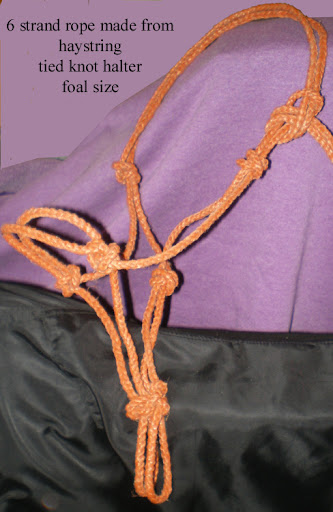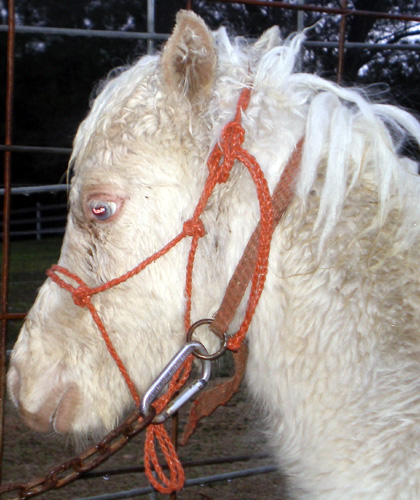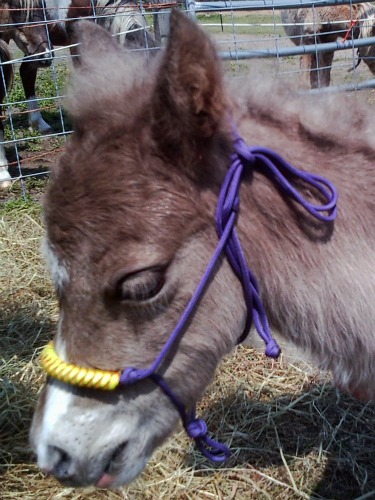I like CA's website. His is very imformative. I am trying to use a little parelli and ca mixed together. I wish the videos weren't so expensive. Also you have to buy the halters, sticks and leads. Wish they would simplify the equipment to keep costs down.
I decided I needed to add my 2 cents worth here... Who says you need to purchase their equipment?
I made my own tie halters - CA's "mini" halter (foal) doesn't have all the knots, so any tie halter that is a "copy" will work if it properly fits your horse. The rope?? Lowes, Home Depot, Tractor Supply Co, many other hardware stores AND other Natural Horse supply stores have the rope. Marine rope is also sold by Marine stores and several have stores online. Personally, I REALLY like MCR (Mountain Climbing Rope) which comes in different metric sizes - so that you can size it to your hands. I've made my own lead ropes, lounge lines, cross ties, trailer ties and halters for years. Now, I have a lot more ponies/minis and find I end up buying more now... YEP, you can get the rope for less than what CA and PP and some others sell theirs for - but then you have to be crafty enuf to make the lead (s). It's not difficult and it IS much cheaper - if that is a concern. I made several no hardware, tie halters out of braided haystring (already paid for from my horse's hay!) - both 4 strand and 6 strand. It comes off of the round bales - the short, cut strings from small square bales doesn't work. You can also make it from paracord - several suppliers out there that have it in different colors (ooooo - you can make them in your barn/farm or your individual horses' color - I LOVE THAT) AND nowadays it comes in different weights (not just 550 cord anymore that started for the soldiers' parachutes). There are several different videos out on YouTube that show how to "tie" the no hardware halters. I purchased my directions from UBraidIt dot com. I also purchased the basic braiding book and then adjusted the sizing to suit - I've even braided breast collar training harness that works for training LOTS of young shetland/minis to drive... Cheap and holds up well. Gives your hands something to do while you are holed up over the winter while watching the DVDs you are going to get...


The 2nd one is braided from 4 strands of haystring. The next one was made by my farrier out of paracord and this is a Shetland filly that will be about 40 - 42" at maturity.

The "carrot stick" - well our feed store carries a "copy" that works well enough. And when I purchased my first one - it was only $15 vs the $50 that some of the others charge for the name. Is it the same? NO, it's not. It's heavier and not balanced anywhere near the same. Also, my copy isn't short enough (to me) to work with the smaller shetlands. Fixed that - used a lounge whip that had broken - and made a tip (duct tape & leather), then attached the "string". I DO like CA's equipment - to be honest. It's weighted different than the rope I can get for much less and make my own. BUT the cost does add up. I'd love to have the children's stick - it's now only 2 ft long vs the 4 ft long one and it's "ergonomic" - it feels great in the hands that are starting to have issues (early stages of arthritis? YIKES), but right now, the cost is something I'd rather put into some other things (like sending a couple of my mini/shetlands to trainers and to Congress and Nationals). There are other stores on line now that carry "carrot sticks" for less than either PP or CA's. (I think Natural Horse Supply is one... I know there are others but don't have the links on this computer, so can't tell you what they are. NHS also has a bunch of short articles on the different training techniques that you can print out and make your own book...)
Last - our own miniature horse stores cary tied rope halters and DVDs on training minis by a trainer that uses NH type techniques. Ozark Mtn Mini horse Tack, Star Lake Farm, Mini Express - etc... Check them out. They don't have the longer lead/lounge lines or the "carrot sticks", tho, LOL.
Over the last 20 years or more, I've gathered a nice library of books from the different trainers - even have a couple from british trainers that are a "twist" on the PP and CA stuff.. Neat to see what they do! The book on bombproofing is also a GREAT one. AND don't discount the training by Linda Tellington Jones - who also has books w/ pictures showing their "style" with ponies and mini's (& they use flat nylon halters w/ stud chains on the lead ropes). John Richard Young put out a book 30 + yrs ago - called "Training the Young Rider" - and it's a big pictorial w/ his daughter and a "wild" pony they purchased. I remember it as being AWESOME and applied a lot of his techniques to my training too (Loved the articles that he used to write for the "Horseman" magazine before it went out of production). I currently don't have a copy of that one and need to get it again. I've been fortunate to be able to go to many clinics - though only a couple by the "big names". Some techniques work for me - others are harder for me to grasp. I sometimes have a tendency to be too aggresive - but even with that, my ponies/minis adjust.
There is a PONY TRAINER on the West Coast (can't remember what state) that uses NH techniques (think mostly PP, but can't remember). She has now written at least one book and also has several YouTube vids up. I think she's PonyPro (s)? Can't remember, sorry. But liked her stuff and was wishing I could send one of my 1/2 arab/shetland ponies to her for riding training - may still evenutally do so, not sure!
Lots of advice from a lot of different people here - I was VERY surprised, myself. Even found a couple names I'd not heard before and will be looking them up!
 I love watching him on his show on RFD TV and i so badly want to go watch his walkabout tours! I have never seen Parelli, going to go watch him now on Youtube......
I love watching him on his show on RFD TV and i so badly want to go watch his walkabout tours! I have never seen Parelli, going to go watch him now on Youtube......





